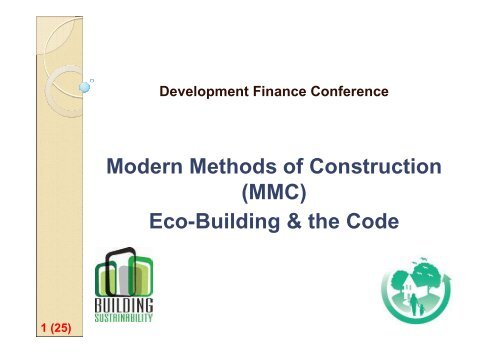Sustainable Building: Introducing MMC & the Code for ... - Buildstore
Sustainable Building: Introducing MMC & the Code for ... - Buildstore
Sustainable Building: Introducing MMC & the Code for ... - Buildstore
Create successful ePaper yourself
Turn your PDF publications into a flip-book with our unique Google optimized e-Paper software.
Development Finance Conference<br />
Modern Methods of Construction<br />
(<strong>MMC</strong>)<br />
Eco-<strong>Building</strong> & <strong>the</strong> <strong>Code</strong><br />
1 (25)
Setting <strong>the</strong> scene<br />
• Modern Methods of Construction (<strong>MMC</strong>) is<br />
being driven by legislation – Materials,<br />
Components & Systems are all being developed<br />
at a greater pace than ever be<strong>for</strong>e in <strong>the</strong><br />
Construction Industry to provide greater Energy<br />
Efficient <strong>Building</strong>s.<br />
• What are <strong>the</strong> Materials, Components &<br />
Systems we have to lend on in <strong>the</strong> future?<br />
2 (25)
Bench Mark – Traditional Build?<br />
Traditional Build in <strong>the</strong> UK - Often referred to<br />
as a ‘brick & block’ cavity wall, but in reality <strong>the</strong><br />
first cavity wall constructed as we know it was<br />
not in evidence until <strong>the</strong> early 1920’s!<br />
(Cavity not insulated at that time).<br />
‘Traditional’ – Typical Example:<br />
<br />
<br />
<br />
<br />
<br />
Brick or Stone External Skin<br />
50mm Cavity (Non Insulated Traditionally)<br />
Block Inner Skin<br />
Clay, Concrete or Slate Tiled Roof<br />
Internal Loadbearing Concrete Block Walls<br />
(Foundations and Ground Slabs not Considered <strong>for</strong> this discussion)<br />
3 (25)
Legislation Forcing Change:<br />
Climate Change is <strong>for</strong>cing an Industry accused<br />
of being ‘reluctant to change’ into adopting new<br />
technologies which reduce our ‘Carbon Footprint’<br />
The <strong>Code</strong> <strong>for</strong> <strong>Sustainable</strong> Homes represents<br />
a ‘Step - Change in <strong>Sustainable</strong> Home <strong>Building</strong> Practice’<br />
The standard <strong>for</strong> key elements of design and construction which affect <strong>the</strong><br />
sustainability of a new home. It will become <strong>the</strong> single national standard <strong>for</strong><br />
sustainable homes, used by home designers and builders as a guide to<br />
development, and by home-buyers to assist in <strong>the</strong>ir choice of home.<br />
4 (25)<br />
Passive House is a per<strong>for</strong>mance based building<br />
standard resulting in a house that consumes as<br />
little as 10% of <strong>the</strong> total heating and cooling energy<br />
used by a house built to <strong>the</strong> 2006 building code.
5 (25)<br />
The <strong>Code</strong> <strong>for</strong> <strong>Sustainable</strong> Homes:
The <strong>Code</strong> <strong>for</strong> <strong>Sustainable</strong> Homes:<br />
Categories<br />
1. Energy & CO² emissions (spec)<br />
2. Water consumption (120 to 105 to 80 litres/person/day) (spec)<br />
3. Environmental impact of materials – responsible sourcing (spec)<br />
4. Surface water run off (spec)<br />
5. Waste management (design)<br />
6. Pollution (spec & design)<br />
7. Health and well being (spec & design)<br />
8. Management (process)<br />
9. Ecology (design & process)<br />
6 (25)
Passive House Standard (PassivHaus):<br />
Passive buildings rely on high levels of insulation and tight control<br />
over airtightness – <strong>Building</strong>s built to this standard can run effectively<br />
on low-volume heat recovery ventilations systems required to<br />
maintain air quality.<br />
7 (25)
Definitions: <strong>MMC</strong> & Eco <strong>Building</strong><br />
Offsite refers to modern methods of<br />
construction which has predominantly been<br />
manufactured & assembled in a factory<br />
controlled environment<br />
Onsite refers to modern methods<br />
of construction which brings<br />
toge<strong>the</strong>r systems or components<br />
which are predominantly<br />
assembled onsite<br />
Eco <strong>Building</strong> (Green <strong>Building</strong>) refers to<br />
construction methods both ‘modern’ & ‘old’ that<br />
embrace ecological & environmental building<br />
techniques, which includes ‘Natural <strong>Building</strong>s’<br />
8 (25)
Systems, Components & Materials:<br />
Systems - define methods of building or techniques which<br />
comprise <strong>the</strong> majority of a building thus defining it as a<br />
system ra<strong>the</strong>r than a component alone:<br />
Timber Frame System, Steel Frame System, etc.<br />
Components - parts of a building made up from singular or<br />
multiple materials which can be offsite or site assembled and<br />
can be used in a variety of ‘System Types’<br />
I Joists, Roof Trusses, SIP’s Roof Cassettes, etc.<br />
Materials - individual elements which combine to<br />
make component parts or full systems. ‘New<br />
Materials’ are being designed as single elements,<br />
components & <strong>the</strong> basis <strong>for</strong> full <strong>Building</strong> Systems<br />
9 (25)
<strong>MMC</strong> – Offsite / Benefits:<br />
The ‘Eternal Triangle’ states that you cannot alter any<br />
one facet without it directly affecting <strong>the</strong> o<strong>the</strong>r two.<br />
<br />
<br />
<br />
Quicker = More cost or less quality<br />
Cheaper = Lower quality<br />
Higher Quality = More time and money<br />
Time<br />
Quality<br />
Cost<br />
10 (25)<br />
Offsite Production Benefits =<br />
Increased Quality and Reduced Time & Cost.<br />
1) Reduced Prelims due to shorter time on site<br />
2) Reduced Project Management costs<br />
3) Reduced Professional Fees<br />
4) Reduced Programme Times<br />
5) Reduced Defects and Rework due to high first time quality<br />
6) Reduced Wastage on site<br />
7) Reduced Wea<strong>the</strong>r Dependency<br />
8) Increased Procurement Strategies<br />
9) Reduced Reliance on Transient Labour<br />
10) Increased Health and Safety on Site
11 (25)<br />
<strong>MMC</strong> – Offsite Systems (Volumetric & Panelised):<br />
1) Timber Frame:<br />
• Closed Cell<br />
• Filled Cell<br />
• Open Cell<br />
2) Lightweight Steel Frame<br />
• Closed Cell<br />
• Open Cell<br />
• Braced Frame<br />
3) Structurally Insulated Panels (SIP’s)<br />
4) Semi SIP’s (Structural Insulation &<br />
Frame)<br />
5) Multi-layered Engineered Timber (Solid)<br />
6) Precast Concrete Panels
12 (25)<br />
Precast Concrete & SIP’s Panels
<strong>MMC</strong> – Onsite Systems:<br />
Onsite Systems comprise many methods which benefit from <strong>the</strong> use<br />
of modern materials. As <strong>the</strong> name implies, <strong>the</strong>se systems are mainly<br />
assembled or constructed ‘Onsite’ – The methods are many and<br />
varied, <strong>the</strong> ‘Systems Approach’ leads to increased speed & quality.<br />
Typical Onsite <strong>MMC</strong> System Types:<br />
• Stick Build Timber Frame<br />
• Insulated Concrete Formwork (ICF)<br />
• Thin Joint Blockwork / Clay Blocks<br />
• Oak Framed <strong>Building</strong>s (Site Assembled)<br />
• Glulaminated Framed <strong>Building</strong> (Site Assembled)<br />
13 (25)
14 (25)<br />
ICF’s – Insulated<br />
Concrete Formwork<br />
On Site <strong>MMC</strong>
<strong>MMC</strong> – Onsite Systems:<br />
Oak & Glulam Framed <strong>Building</strong>s – Post &<br />
Beam type systems can still be classified<br />
as <strong>MMC</strong> as often <strong>the</strong> framework is used as<br />
<strong>the</strong> Primary Structure & Insulated Panels<br />
are used to provide <strong>the</strong> walling elements.<br />
Thin Joint Blockwork & Clay Blocks –<br />
Manufactured to high tolerances which enables<br />
very thin joints between blocks to be made -<br />
Increasing <strong>the</strong> <strong>the</strong>rmal per<strong>for</strong>mance by reducing<br />
<strong>the</strong> joint thickness & improving Air Tightness,<br />
o<strong>the</strong>r benefits include increased speed on site<br />
and wastage reduction.<br />
15 (25)
16 (25)<br />
Typical Lightweight Thin<br />
Joint Blockwork<br />
On Site <strong>MMC</strong>
Eco <strong>Building</strong> (Green <strong>Building</strong>s):<br />
Eco <strong>Building</strong>s, Green <strong>Building</strong>s & Natural <strong>Building</strong>s – Range of<br />
Systems with a major emphasis on Sustainability using natural resources<br />
with minimal processing.<br />
(This can include recycled or salvaged products, such as Car Tyres & Glass Bottles)<br />
Typical Eco <strong>Building</strong> System Types:<br />
• Subterranean<br />
• Earth Sheltered (Bermed)<br />
• Earth <strong>Building</strong>s (Rammed Earth, Earth Bag, Cob)<br />
• Hempcrete<br />
• Straw<br />
• Recycled Car Tyres & Glass Bottles (Earthship)<br />
17 (25)
Eco <strong>Building</strong> Systems Examples:<br />
Hempcrete & Earth <strong>Building</strong>s<br />
(Rammed Earth, Cob & Earth Bag)<br />
<strong>Building</strong>s constructed using natural<br />
materials such as Hemp Stalks & Lime,<br />
Straw, Clay & Sand, and Sturdy Bags filled<br />
with Sand, Gravel & Clay or materials<br />
found locally on site.<br />
18 (25)<br />
Earth Sheltered & Bermed<br />
Can be completely subterranean or partly<br />
above ground with part or whole of <strong>the</strong><br />
building covered with earth usually<br />
‘bermed’ against <strong>the</strong> wall panel.<br />
The type of structure can be varied<br />
depending upon <strong>the</strong> design.
19 (25)<br />
Rammed Earth
<strong>MMC</strong> – Components & Materials:<br />
<strong>MMC</strong> is not limited to Systems, it embraces Components & Materials<br />
which make up <strong>the</strong> components <strong>the</strong>mselves.<br />
Components can <strong>for</strong>m individual elements, or <strong>the</strong> assembly of many<br />
materials & Sub Components which can be used on a variety of System<br />
types previously looked at.<br />
20 (25)<br />
Typical <strong>MMC</strong> Components:<br />
• SIP’s Roof Cassettes<br />
• Pre Assembled Roof Structures<br />
• Pre Assembled Floor Cassettes<br />
• I joists<br />
• Box Beams<br />
• Open Web Joists<br />
• Trussed Rafters
<strong>MMC</strong> Flat Roofing Materials:<br />
Flat Roofing Options:<br />
Bituminous Felt<br />
<br />
<br />
<br />
The cheapest option usually installed under guarantee<br />
Limited life span<br />
Deteriorates in ultra violet light<br />
Fibreglass:<br />
<br />
<br />
Built up on site, multi operation<br />
Bullet proof but not so flexible<br />
Lead:<br />
<br />
<br />
Fantastic product and <strong>the</strong> longest life span<br />
But <strong>the</strong> most expensive option<br />
Single Ply Membranes:<br />
<br />
<br />
<br />
Single Ply membranes (Sarnafil)<br />
Often used with green roof construction<br />
Specialist installation – fully guaranteed<br />
21 (25)
<strong>MMC</strong> – Materials <strong>for</strong> <strong>the</strong> Future:<br />
1. There are many new materials which are<br />
being specifically designed to solve<br />
many of <strong>the</strong> problems which we now<br />
face in daily construction.<br />
2. Technology can help with <strong>the</strong><br />
Sustainability of new construction<br />
systems by designing new materials<br />
which are deemed ‘intelligent’ and can<br />
function on a number of levels.<br />
3. There are far too many new material<br />
innovations to discuss with any detail<br />
here, but it should be realised that as <strong>the</strong><br />
speed <strong>for</strong> change increases, so does <strong>the</strong><br />
introduction of new materials to deal with<br />
those changes.<br />
22 (25)
<strong>MMC</strong> – Phase Change Materials (PCM’s):<br />
23 (25)<br />
Phase Change Materials (PCM’s)<br />
Thermal Mass, as its name implies, involves<br />
using ‘mass’ to absorb & release heat to help<br />
regulate our buildings.<br />
PCM’s provide a lightweight solution which<br />
has been termed ‘lightweight <strong>the</strong>rmal mass’<br />
or ‘virtual mass’ and <strong>the</strong>re are a number of<br />
products which are becoming mainstream.<br />
PCM’s are ones which change <strong>the</strong>ir phase<br />
from one state to ano<strong>the</strong>r when absorbing or<br />
releasing energy. – Water / Ice / Water<br />
Micro – Encapsulated Wax per<strong>for</strong>ms well but<br />
has to be contained & protected from fire,<br />
new PCM’s are now being put in fire proof<br />
structural & non structural boards.<br />
Amount of material required <strong>for</strong> equivalent <strong>the</strong>rmal<br />
mass<br />
Equivalent Thermal Mass (cm)<br />
0 5 10 15 20 25 30 35<br />
PCM<br />
Brick<br />
Sandstone<br />
Concrete<br />
Wood<br />
Gypsum<br />
Source: International Energy Agency
<strong>MMC</strong> – Boards & Thin Insulation:<br />
New Construction Boards:<br />
With <strong>the</strong> advent of new glue & resin technologies, it<br />
is possible to <strong>for</strong>mulate boards which per<strong>for</strong>m on a<br />
number of levels, providing structural rigidity, fire<br />
proofing, breathability & in this photo contain Micro<br />
Encapsulated Wax PCM’s.<br />
Thin Insulations:<br />
As <strong>the</strong> drive <strong>for</strong> thinner materials continue,<br />
insulation is a prime contender as usually<br />
additional insulation requires additional thickness.<br />
Using Nano Technology, modern insulation<br />
materials can be thin & high per<strong>for</strong>ming – 10mm<br />
thick Aerogel = 20mm rigid and 50mm Glasswool<br />
24 (25)
Regulation & Lending:<br />
Conclusion:<br />
1. As Legislation <strong>for</strong>ces change<br />
2. Manufacturers continue to innovate<br />
3. Systems continually evolve<br />
4. Authorities/Warrantors become more integrated<br />
5. Training skills develop<br />
6. Lenders rely on improved overall standards<br />
25 (25)













